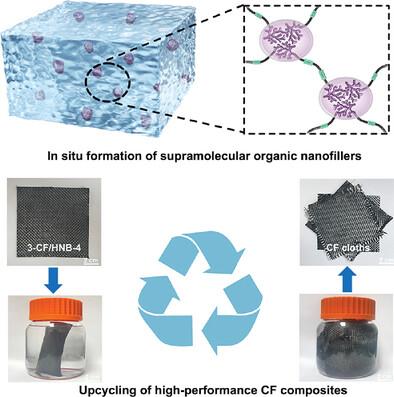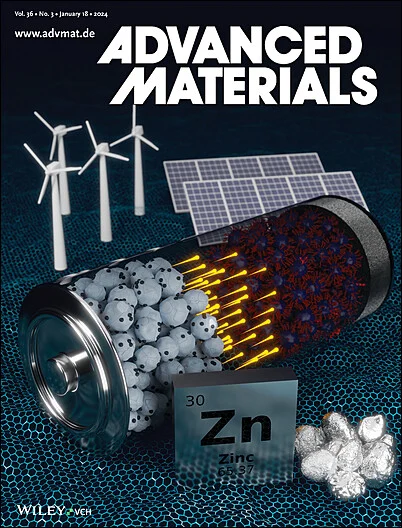超分子有机纳米填料:面向碳纤维复合材料升级循环的动态共价聚合物网络增强新策略
IF 27.4
1区 材料科学
Q1 CHEMISTRY, MULTIDISCIPLINARY
引用次数: 0
摘要
动态共价聚合物网络(DCPN)为热固性弹性体的可回收性提供了一个重要的解决方案。然而,动态键的键能相对较弱,大大降低了DCPN的力学性能。本文提出了一种新的DCPN增强策略,通过异步聚合在原位形成超分子有机纳米填料。由于异氰酸酯基团的反应活性差异和醛胺的逐渐解嵌,六亚乙烯二异氰酸酯和异氰酸酯端端含有动态肟-氨基甲酸酯键的预聚物与解嵌的三(2-氨基乙基)胺的异步交联有利于从分子链的互穿过渡到不混相聚合。这导致超支化团簇和长链之间的热力学不相容,诱导超分子有机纳米填料的自发形成。与传统的增强策略相比,超分子有机纳米填料显著提高了DCPN的力学性能。此外,超支化簇和动态肟-氨基甲酸乙酯键之间的超分子相互作用使网络具有良好的可回收性。所制备的DCPN具有独特的增强性和可回收性,可以与碳纤维(CF)结合形成具有优异性能的CF复合材料,用于个人防护应用,实现CF复合材料的升级回收。本研究为DCPN的增强和高性能CF复合材料的升级利用提供了一种新的策略。本文章由计算机程序翻译,如有差异,请以英文原文为准。

Supramolecular Organic Nanofiller: A New Reinforcement Strategy for Dynamic Covalent Polymer Networks Toward Upcycling of Carbon Fiber Composites
Dynamic covalent polymer networks (DCPN) provide an important solution to the challenging recyclability of thermoset elastomers. However, dynamic bonds exhibit relatively weak bond energies, considerably decreasing the mechanical properties of DCPN. Herein, a novel reinforcement strategy for DCPN involving the in situ formation of supramolecular organic nanofillers through asynchronous polymerization is proposed. Owing to the difference in the reactivity of the isocyanate groups and the gradual deblocking of aldimine, asynchronous cross-linking of hexamethylene diisocyanate and isocyanate-terminated prepolymer containing dynamic oxime–urethane bonds with the deblocked tris(2-aminoethyl)amine facilitates the transition from the molecular interpenetration of chains into immiscible polymerization. This results in thermodynamic incompatibility between the hyperbranched clusters and long chains, inducing a spontaneous formation of supramolecular organic nanofillers. Compared to traditional reinforcement strategies, supramolecular organic nanofillers considerably improve the mechanical properties of DCPN. Furthermore, the supramolecular interactions between hyperbranched clusters and dynamic oxime–urethane bonds enable the network with excellent recyclability. The unique reinforcement and recyclability of the prepared DCPN allow their combination with carbon fibers (CF) to form CF composites with outstanding properties for personal-protection applications, achieving CF composite upcycling. This study offers a novel strategy on the reinforcement of DCPN and the upcycling of high-performance CF composites.
求助全文
通过发布文献求助,成功后即可免费获取论文全文。
去求助
来源期刊

Advanced Materials
工程技术-材料科学:综合
CiteScore
43.00
自引率
4.10%
发文量
2182
审稿时长
2 months
期刊介绍:
Advanced Materials, one of the world's most prestigious journals and the foundation of the Advanced portfolio, is the home of choice for best-in-class materials science for more than 30 years. Following this fast-growing and interdisciplinary field, we are considering and publishing the most important discoveries on any and all materials from materials scientists, chemists, physicists, engineers as well as health and life scientists and bringing you the latest results and trends in modern materials-related research every week.
 求助内容:
求助内容: 应助结果提醒方式:
应助结果提醒方式:


